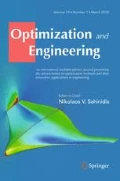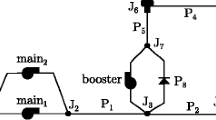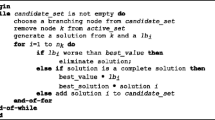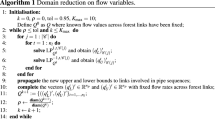Abstract
This paper offers a novel approach for computing globally optimal solutions to the pump scheduling problem in drinking water distribution networks. A tailored integer linear relaxation of the original non-convex formulation is devised and solved by branch and bound where integer nodes are investigated through non-linear programming to check the satisfaction of the non-convex constraints and compute the actual cost. This generic method can tackle a large variety of networks, e.g. with variable-speed pumps. We also propose to specialize it for a common subclass of networks with several improving techniques, including a new primal heuristic to repair near-feasible integer relaxed solutions. Our approach is numerically assessed on various case studies of the literature and compared with recently reported results.


Similar content being viewed by others
Notes
With respect to Costa et al. (2016), we connect the water tanks 165 and 265 with a pipe of zero length to prevent non-physical behaviors induced by the discretization, especially with long time steps. This change is justified by the fact that the head levels in the two tanks are always very close, as shown in Figure 8 of Costa et al. (2016). The alternative used in Costa et al. (2016) is to run the extended period analysis on a smaller time step.
To use our MINLP formulation, we made three modifications: 1) the minimal pressure level \(\overline{P}\) is only required for internal nodes with positive demands, 2) we modeled the complex operation of the water tanks (see Eq.(5)–(9) in Verleye and Aghezzaf (2013)) by preceding each water tank with a PRV, 3) we dropped the operating constraints related to raw water pump.
The authors of Ghaddar et al. (2015) and Naoum-Sawaya et al. (2015) do not mention check valves in their mathematical formulation, but likely include them in the hydraulic model of EPANET. That could explain the inconsistency between the lower bounds reported in Ghaddar et al. (2015) and our results.
References
Balas E, Jeroslow R (1972) Canonical cuts on the unit hypercube. SIAM J Appl Math 23:61–69
Belotti P, Kirches C, Leyffer S, Linderoth J, Luedtke J, Mahajan A (2013) Mixed-integer nonlinear optimization. Acta Numer 22:1–131
Bonami P, Biegler LT, Conn AR, Cornuéjols G, Grossmann IE, Laird CD, Lee J, Lodi A, Margot F, Sawaya N, Wächter A (2008) An algorithmic framework for convex mixed integer nonlinear programs. Discrete Optim 5(2):186–204
Bonvin G, Demassey S, Le Pape C, Maïzi N, Mazauric V, Samperio A (2017) A convex mathematical program for pump scheduling in a class of branched water networks. Appl Energy 185:1702–1711
Bragalli C, D’Ambrosio C, Lee J, Lodi A, Toth P (2012) On the optimal design of water distribution networks: a practical MINLP approach. Optim Eng 13(2):219–246
Burgschweiger J, Gnädig B, Steinbach MC (2009) Nonlinear programming techniques for operative planning in large drinking water networks. Open Appl Math J 3:14–28
Burgschweiger J, Gnädig B, Steinbach MC (2009) Optimization models for operative planning in drinking water networks. Optim Eng 10(1):43–73
Carlson R (2000) The correct method of calculating energy savings to justify adjustable-frequency drives on pumps. IEEE Trans Indus Appl 36(6):1725–1733
Costa LHM, de Athayde Prata B, Ramos HM, de Castro MAH (2016) A branch-and-bound algorithm for optimal pump scheduling in water distribution networks. Water Resour Manag 30(3):1037–1052
D’Ambrosio C, Lodi A (2013) Mixed integer nonlinear programming tools: an updated practical overview. Ann Oper Res 204(1):301–320
D’Ambrosio C, Frangioni A, Liberti L, Lodi A (2010) On interval-subgradient and no-good cuts. Oper Res Lett 38(5):341–345
D’Ambrosio C, Lodi A, Wiese S, Bragalli C (2015) Mathematical programming techniques in water network optimization. Eur J Oper Res 243(3):774–788
Dan T, Lodi A, Marcotte P (2018) An exact algorithm for a class of mixed-integer programs with equilibrium constraints. Technical Report DS4DM-2018-010, École Polytechnique de Montréal
de La Perriére L, Jouglet A, Nace A, Nace D (2014) Water planning and management: An extended model for the real-time pump scheduling problem. In: Advances in hydroinformatics, pages 153–170. Springer, Berlin
Eck Bradley J, Mevissen M (2012) Valve placement in water networks: Mixed-integer non-linear optimization with quadratic pipe friction. Technical report, IBM Research Report
European Commission. 2030 energy strategy (2014) ec.europa.eu/energy/en/topics/energy-strategy/2030-energy-strategy[accessed: 18-Apr-2017]
Federal Ministry for Economic Affairs and Energy (BMWi) (2014) An Electricity Market for Germany’s Energy Transition (Green Paper)
Feldman M (2009) Aspects of energy efficiency in water supply systems. In: The 5th IWA water loss reduction Specialist Conference. pp 85–89, Capetown, South Africa
Geißler B, Kolb O, Lang J, Leugering G, Martin A, Morsi A (2011) Mixed integer linear models for the optimization of dynamical transport networks. Math Methods Oper Res 73(3):339–362
Ghaddar B, Naoum-Sawaya J, Kishimoto A, Taheri N, Eck B (2015) A lagrangian decomposition approach for the pump scheduling problem in water networks. Eur J Oper Res 241(2):490–501
Giacomello C, Kapelan Z, Nicolini M (2013) Fast hybrid optimization method for effective pump scheduling. J Water Resour Plan Manag 139(2):175–183
Gleixner A, Held H, Huang W, Vigerske S (2012) Towards globally optimal operation of water supply networks. Numer Algeb Control Optim 2(4):695–711
Gleixner A, Berthold T, Müller B, Weltge S (2017) Three enhancements for optimization-based bound tightening. J Global Optim 67(4):731–757
Gurobi Optimization Inc (2016) Gurobi optimizer reference manual
Hart WE, Laird CD, Watson J-P, Woodruff DL, Hackebeil GA, Nicholson BL, Siirola JD (2017) Pyomo-optimization modeling in python, vol 67, 2nd edn. Springer, Berlin
Humpola J, Serrano F (2017) Sufficient pruning conditions for MINLP in gas network design. EURO J Comput Optim 5(1–2):239–261
Humpola J, Fügenschuh A (2013) A new class of valid inequalities for nonlinear network design problems. Technical report, Zuse-Institut, Berlin
Krakowski V, Assoumou E, Mazauric V, Maïzi N (2016) Reprint of feasible path toward 40–100 power supply in france by 2050: A prospective analysis. Appl Energy 184:1529–1550
Lansey KE, Awumah K (1994) Optimal pump operations considering pump switches. J Water Resour Plan Manag 120(1):17–35
López-Ibáñez M, Prasad TD, Paechter B (2008) Ant colony optimization for the optimal control of pumps in water distribution networks. J Water Resour Plan Manag 134(4):337
Mala-Jetmarova H, Sultanova N, Savić D (2017) Lost in optimisation of water distribution systems? a literature review of system operation. Environ Modell Softw 93:209–254
McCormick G, Powell R (2004) Derivation of near-optimal pump schedules for water distribution by simulated annealing. J Oper Res Soc 55(7):728–736
Menke R, Abraham E, Stoianov I (2016) Modeling variable speed pumps for optimal pumpscheduling. In: World Environmental and Water Resources Congress, pp 199–209
Menke R, Abraham E, Parpas P, Stoianov I (2016) Demonstrating demand response from water distribution system through pump scheduling. Appl Energy 170:377–387
Menke R, Abraham E, Parpas P, Stoianov I (2016) Exploring optimal pump scheduling in water distribution networks with branch and bound methods. Water Resour Manag 30(14):1–17
Morsi A, Geißler B, Martin A (2012) Mixed integer optimization of water supply networks. In: Mathematical Optimization of Water Networks, pp 35–54. Springer, Berlin
Naoum-Sawaya J, Ghaddar B, Arandia E, Eck B (2015) Simulation-optimization approaches for water pump scheduling and pipe replacement problems. Eur J Oper Res 246(1):293–306
Nault J, Papa F (2015) Lifecycle assessment of a water distribution system pump. J Water Resour Plan Manag 141(12):A4015004
Ormsbee L, Lansey K (1994) Optimal control of water supply pumping systems. J Water Resour Plan Manag 120(2):237–252
Ormsbee L, Walski T, Chase D, Sharp W (1989) Methodology for improving pump operation efficiency. J Water Resour Plan Manag 115(2):148–164
Pecci F, Abraham E, Stoianov I (2017) Quadratic head loss approximations for optimisation problems in water supply networks. Journal of Hydroinformatics 19(4):493–506
Quesada I, Grossmann IE (1992) An LP/NLP based branch and bound algorithm for convex MINLP optimization problems. Comput Chem Eng 16(10–11):937–947
Raghunathan A (2013) Global optimization of of nonlinear network design. SIAM J Optim 23(1):268–295
Rao Z, Alvarruiz F (2007) Use of an artificial neural network to capture the domain knowledge of a conventional hydraulic simulation model. J Hydroinformatics 9(1):15–24
Rossman L (2000) EPANET 2: users manual
Sahinidis N (2017) BARON 17.8.9: Global Optimization of Mixed-Integer Nonlinear Programs, User’s Manual
Salgado-Castro RO (1988) Computer modelling of water supply distribution networks using the gradient method. PhD thesis, Newcastle University
SEMO (2016) Single electricity market operator
Shi H, You F (2016) Energy optimization of water supply system scheduling: Novel MINLP model and efficient global optimization algorithm. AIChE J 62(12):4277–4296
Simpson A, Dandy G, Murphy L (1994) Genetic algorithms compared to other techniques for pipe optimization. J Water Resour Plan Manag 120(4):423–443
Skworcow P, Paluszczyszyn D, Ulanicki B (2014) Pump schedules optimisation with pressure aspects in complex large-scale water distribution systems. Drinking Water Eng Sci 7(1):53–62
Smith E, Pantelides C (1997) Global optimisation of nonconvex MINLPs. Comput Chem Eng 21:S791–S796
Thorsteinsson E (2001) Branch-and-check: A hybrid framework integrating mixed integer programming and constraint logic programming. In International Conference on Principles and Practice of Constraint Programming (CP’01), Vol 2239 of Lecture Notes in Computer Science, pp 16–30
Todini E, Pilati S (1988) A gradient algorithm for the analysis of pipe networks. In: Bryan C, Chun-Hou O (eds) Computer Applications in Water Supply: Vol. 1—systems Analysis and Simulation. Research Studies Press Ltd., Taunton, UK, pp 1–20
van Zyl J, Savić D, Walters G (2004) Operational optimization of water distribution systems using a hybrid genetic algorithm. J Water Resour Plan Manag 130:160–170
Verleye D, Aghezzaf E-H (2013) Optimising production and distribution operations in large water supply networks: a piecewise linear optimisation approach. Int J Prod Res 51(23–24):7170–7189
Walski TM, Downey Brill Jr E, Gessler J, Goulter IC, Jeppson RM, Lansey K, Lee H-L, Liebman JC, Mays L, Morgan DR et al (1987) Battle of the network models: Epilogue. J Water Resour Plan Manag 113(2):191–203
Acknowledgements
We would like to thank Bradley Eck, Joe Naoum-Sawaya, Bruno de Athayde Prata, Hanyu Shi and Derek Verleye for sharing with us some complementary elements concerning their respective data and for providing us technical details concerning their model. The work of Gratien Bonvin was partially supported by a Doc.Mobility Grant (P1SKP2_174858) from the Swiss National Science Foundation. We are indebted to three anonymous referees for a careful reading and some very useful suggestions.
Author information
Authors and Affiliations
Corresponding author
Ethics declarations
Data Availability
The material related to the reproduction of the experiments is available under request to the second author. Parts of the code are also available through the GOPS (Global Optimisation for Pump Scheduling) project under the terms of the GPL license and can be downloaded at https://github.com/sofdem/gopslpnlpbb.
Additional information
Publisher's Note
Springer Nature remains neutral with regard to jurisdictional claims in published maps and institutional affiliations.
Rights and permissions
About this article
Cite this article
Bonvin, G., Demassey, S. & Lodi, A. Pump scheduling in drinking water distribution networks with an LP/NLP-based branch and bound. Optim Eng 22, 1275–1313 (2021). https://doi.org/10.1007/s11081-020-09575-y
Received:
Revised:
Accepted:
Published:
Issue Date:
DOI: https://doi.org/10.1007/s11081-020-09575-y




